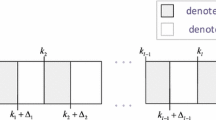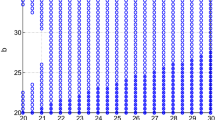Abstract
In this paper, the stabilization problem of Takagi–Sugeno (T–S) fuzzy system with input constraints is investigated via a membership function-dependent Lyapunov function (MFDLF). First of all, a membership function-dependent sector condition is adopted to address the input saturation. Then, the average dwell-time (ADT) switching technique is applied to handle the time derivatives of the membership functions, which significantly reduces the conservativeness of the results. Next, on the basis of Lyapunov stability tool, the necessary conditions for the exponential stability are proposed under a non-PDC fuzzy control scheme. Furthermore, the polynomial membership function-dependent matrices are introduced, which achieves the extension of the linear switching to quadratic switching, and further relaxes the conditions. Finally, numerical simulation examples are given for verification.




Similar content being viewed by others
Data availability
No datasets were generated or analysed during the current study.
References
Takagi, T., Sugeno, M.: Fuzzy identification of systems and its applications to modeling and control. IEEE Trans. Syst. Man Cybern. 15(1), 116–132 (1985)
Wang, L.X.: Adaptive Fuzzy Systems and Control: Design and Stability Analysis. Prentice-Hall Inc (1994)
Boyd, S., El Ghaoui, L., Feron, E., Balakrishnan, V.: Linear Matrix Inequalities in System and Control Theory. SIAM (1994)
Hu, T., Lin, Z., Chen, B.M.: An analysis and design method for linear systems subject to actuator saturation and disturbance. Automatica 38(2), 351–359 (2002)
Lee, S.M., Kwon, O.M., Park, J.H.: Regional asymptotic stability analysis for discrete-time delayed systems with saturation nonlinearity. Nonlinear Dyn. 67(1), 885–892 (2012)
Nguyen, A.-T., Dambrine, M., Lauber, J.: Lyapunov-based robust control design for a class of switching non-linear systems subject to input saturation: application to engine control. IET Control Theory Appl. 8(17), 1789–1802 (2014)
Tarbouriech, S., Garcia, G., da Silva Jr, J.M.G., Queinnec, I.: Stability and Stabilization of Linear Systems with Saturating Actuators. Springer (2011)
Cao, Y.-Y., Lin, Z.: Robust stability analysis and fuzzy-scheduling control for nonlinear systems subject to actuator saturation. IEEE Trans. Fuzzy Syst. 11(1), 57–67 (2003)
Da Silva, J.G., Tarbouriech, S., Reginatto, R.: Analysis of regions of stability for linear systems with saturating inputs through an anti-windup scheme. In: Proceedings of the International Conference on Control Applications, 2, 1106–1111 IEEE (2002)
Tanaka, K., Wang, H.O.: Fuzzy Control Systems Design and Analysis: A Linear Matrix Inequality approach. Wiley (2004)
Da Silva, J.G., Tarbouriech, S.: Antiwindup design with guaranteed regions of stability: an LMI-based approach. IEEE Trans. Autom. Control 50(1), 106–111 (2005)
Montagner, V.F., Oliveira, R.C.L.F., Peres, P.L.D.: Convergent LMI relaxations for quadratic stabilizability and \({{\mathscr {H}}}_{\infty }\) control of Takagi–Sugeno fuzzy systems. IEEE Trans. Fuzzy Syst. 17(4), 863–873 (2009)
Vafamand, N., Asemani, M.H., Khayatiyan, A.: A robust \({{\cal{L} }}_{1}\) controller design for continuous-time TS systems with persistent bounded disturbance and actuator saturation. Eng. Appl. Artif. Intell. 56, 212–221 (2016)
Hussain, M., Rehan, M., Ahn, C.K., Zheng, Z.: Static anti-windup compensator design for nonlinear time-delay systems subjected to input saturation. Nonlinear Dyn. 95(3), 1879–1901 (2019)
Guerra, T.M., Vermeiren, L.: LMI-based relaxed nonquadratic stabilization conditions for nonlinear systems in the Takagi–Sugeno’s form. Automatica 40(5), 823–829 (2004)
Zeng, Y., Lam, H.-K., Xiao, B., Wu, L.: Tracking control for nonlinear systems with actuator saturation via interval type-2 T-S fuzzy framework. IEEE Trans. Cybern. 53(11), 7085–7094 (2023)
Mozelli, L.A., Palhares, R.M., Avellar, G.S.: A systematic approach to improve multiple Lyapunov function stability and stabilization conditions for fuzzy systems. Inf. Sci. 179(8), 1149–1162 (2009)
Kim, S.H.: Toward less conservative stability and stabilization conditions for T-S fuzzy systems. Nonlinear Dyn. 75(4), 621–632 (2014)
Kennouche, A., Saifia, D., Chadli, M., Labiod, S.: Adaptive fuzzy observer based non-quadratic control for nonlinear system subject to actuator faults and saturation. J. Franklin Inst. 360(8), 5411–5441 (2023)
Nguyen, A.-T., Márquez, R., Dequidt, A.: An augmented system approach for LMI-based control design of constrained Takagi–Sugeno fuzzy systems. Eng. Appl. Artif. Intell. 61, 96–102 (2017)
Kim, S.H.: Local nonquadratic stabilization of T-S fuzzy systems via improved slack-variable-free relaxation technique under a limited operating region. Nonlinear Dyn. 111(13), 12233–12251 (2023)
Nguyen, A.-T., Laurain, T., Palhares, R., Lauber, J., Sentouh, C., Popieul, J.-C.: LMI-based control synthesis of constrained Takagi–Sugeno fuzzy systems subject to \({{\cal{L}}}_{2}\) or \({{\cal{L} }}_{\infty }\) disturbances. Neurocomputing 207, 793–804 (2016)
Zou, T., Li, S.: Stabilization via extended nonquadratic boundedness for constrained nonlinear systems in Takagi–Sugeno’s form. J. Franklin Inst. 348(10), 2849–2862 (2011))
Tiko, S., Mesquine, F.: Constrained control for a class of TS fuzzy systems. IEEE Trans. Fuzzy Syst. 31(1), 348–353 (2022))
Pan, J.-T., Guerra, T.M., Fei, S.-M., Jaadari, A.: Nonquadratic stabilization of continuous T-S fuzzy models: LMI solution for a local approach. IEEE Trans. Fuzzy Syst. 20(3), 594–602 (2012)
Wang, L., Lam, H.K.: H\(\infty \) control for continuous-time Takagi-Sugeno fuzzy model by applying generalized Lyapunov function and introducing outer variables. Automatica 125, 109409 (2021)
Wang, L., Liu, J., Lam, H.-K.: New results of observer design for continuous-time fuzzy systems: a switching technique. IEEE Trans. Syst. Man Cybern. Syst. 52(9), 5702–5706 (2021)
Lopes, A.N., Leite, V.J., Silva, L.F., Guelton, K.: Anti-windup TS fuzzy PI-like control for discrete-time nonlinear systems with saturated actuators. Int. J. Fuzzy Syst. 22(1), 46–61 (2020)
Zare, I., Asemani, M.H., Setoodeh, P.: Active adaptive observer-based fault-tolerant control strategy for a class of T-S fuzzy systems with unmeasurable premise variables. IEEE Trans. Fuzzy Syst. 31(10), 3543–3554 (2023)
Silva, L.F., Leite, V.J., Castelan, E.B., Klug, M., Guelton, K.: Local stabilization of nonlinear discrete-time systems with time-varying delay in the states and saturating actuators. Inf. Sci. 518, 272–285 (2020)
Liberzon, D.: Switching in Systems and Control, vol. 190. Springer (2003)
Mozelli, L.A., Palhares, R.M., Souza, F., Mendes, E.M.: Reducing conservativeness in recent stability conditions of TS fuzzy systems. Automatica 45(6), 1580–1583 (2009)
Funding
This work was supported in part by the National Natural Science Foundation of China under Grant 62173123, in part by the Natural Science Foundation of Hebei Province under Grant F2021202045, and in part by the Natural Science Foundation of Tianjin under Grant 23JCYBJC00930.
Author information
Authors and Affiliations
Contributions
All authors contributed to the study conception and design. The main idea and method were proposed by [Likui Wang]. The first draft of the manuscript was written by [Weihua Wang]. [Xiangpeng Xie] and [Hak-Keung Lam] commented on previous versions of the manuscript. All authors read and approved the final manuscript
Corresponding author
Ethics declarations
Conflict of interest
The authors declare no competing interests.
Additional information
Publisher's Note
Springer Nature remains neutral with regard to jurisdictional claims in published maps and institutional affiliations.
Rights and permissions
Springer Nature or its licensor (e.g. a society or other partner) holds exclusive rights to this article under a publishing agreement with the author(s) or other rightsholder(s); author self-archiving of the accepted manuscript version of this article is solely governed by the terms of such publishing agreement and applicable law.
About this article
Cite this article
Wang, W., Wang, L., Xie, X. et al. A switching control approach for stability analysis of constrained T–S fuzzy systems. Nonlinear Dyn 112, 8249–8259 (2024). https://doi.org/10.1007/s11071-024-09507-w
Received:
Accepted:
Published:
Issue Date:
DOI: https://doi.org/10.1007/s11071-024-09507-w




